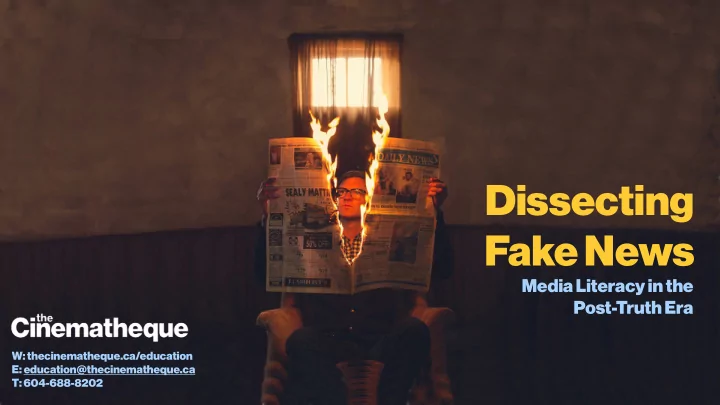

Dissecting Fake News Media Literacy in the Post-Truth Era W: thecinematheque.ca/education E: education@thecinematheque.ca T: 604-688-8202
What is “Fake News”? 1. False information posted on “news” websites (that mimic real ones).
What is “Fake News”? 1. False information posted on “news” websites (that mimic real ones). Solutions: Read the “About Us” section. Pay attention to the domain name. Consult the experts. Reverse Google Image Search.
What is “Fake News”? 1. False information posted on “news” websites (that mimic real ones). 2 . Satirical websites taken seriously.
What is “Fake News”? 1. False information posted on “news” websites (that mimic real ones). 2 . Satirical websites taken seriously. Solutions: Look closer!
What is “Fake News”? 1. False information posted on “news” websites (that mimic real ones). 2 . Satirical websites taken seriously. 3 . Native Advertising (advertising disguised as “news” or articles).
What is “Fake News”? 1. False information posted on “news” websites (that mimic real ones). 2 . Satirical websites taken seriously. 3 . Native Advertising (advertising disguised as “news” or articles. Solutions: Ask critical questions. Determine the subtext. Look for the words: “Sponsored Content”
What is “Fake News”? 1. False information posted on “news” websites (that mimic real ones). 2 . Satirical websites taken seriously. 3 . Native Advertising (advertising disguised as “news” or articles. 4 . Slanted or biased news.
What is “Fake News”? 1. False information posted on “news” websites (that mimic real ones). 2 . Satirical websites taken seriously. 3 . Native Advertising (advertising disguised as “news” or articles. 4 . Slanted or biased news. Solutions: Make sure you read all the articles beyond the headlines. Seek out a critique of the article or argument. Use the Critical Thinking and Stanford resource guides.
The Psychology of Fake News Confirmation Bias/Myside Bias Availability Heuristic
Online Tools Please also see our handout provided on TeachBC.
Recommend
More recommend